Business Strategy Analysis: Tesco's Internal and External Factors
VerifiedAdded on 2020/10/22
|16
|5727
|479
Report
AI Summary
This report provides a comprehensive analysis of Tesco's business strategy. It begins with an introduction to business strategy and its importance in achieving organizational goals. The report then delves into Task 1, which examines the impact and influence of the macro environment on Tesco using PESTLE analysis, covering political, economic, social, technological, environmental, and legal factors. Task 2 analyzes Tesco's internal environment and capabilities using SWOT analysis, evaluating its strengths, weaknesses, opportunities, and threats. Task 3 applies Porter's Five Forces model to assess the competitive forces within the market. Finally, Task 4 focuses on applying various theories, concepts, and models to devise strategic planning for Tesco. The report concludes with a summary of findings and a list of references.
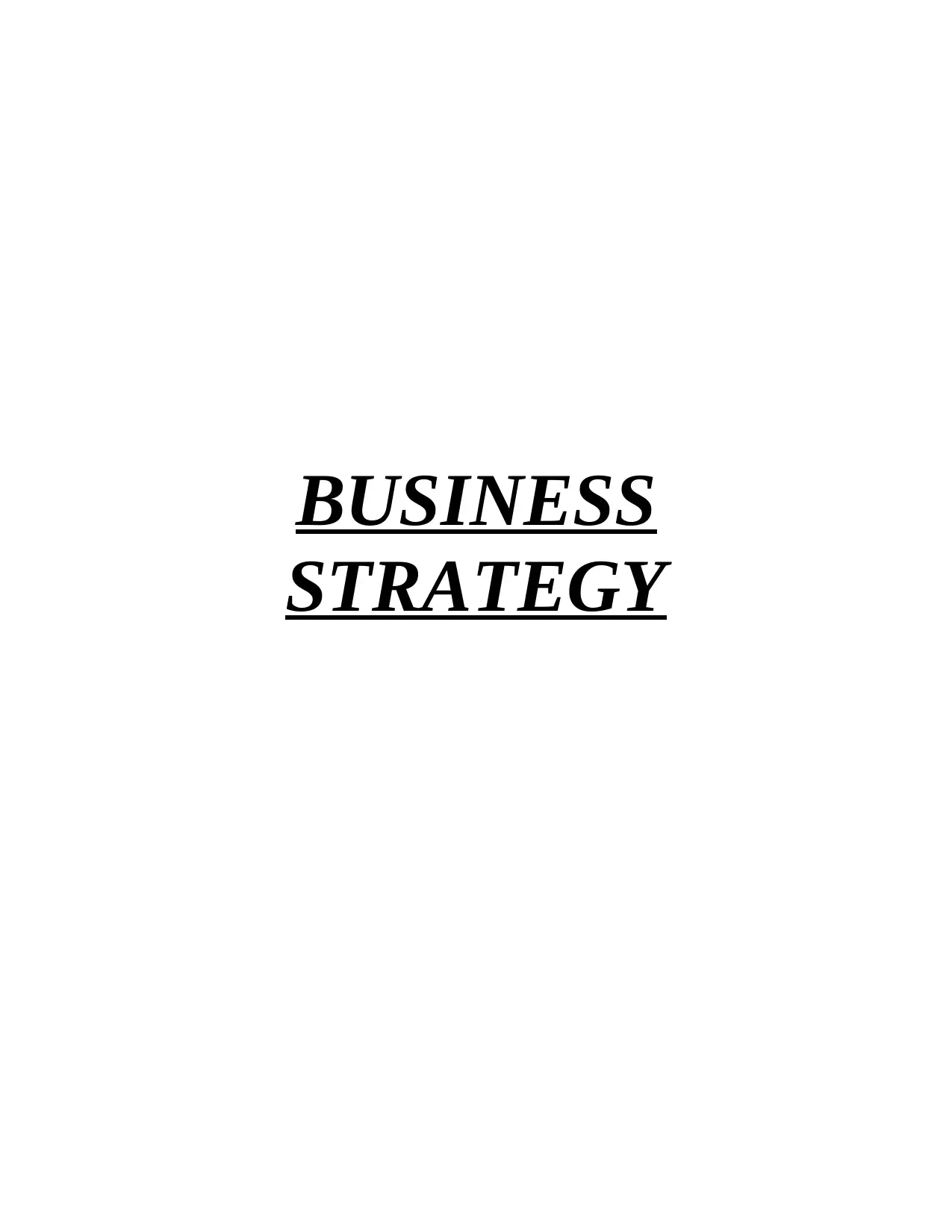
BUSINESS
STRATEGY
STRATEGY
Paraphrase This Document
Need a fresh take? Get an instant paraphrase of this document with our AI Paraphraser
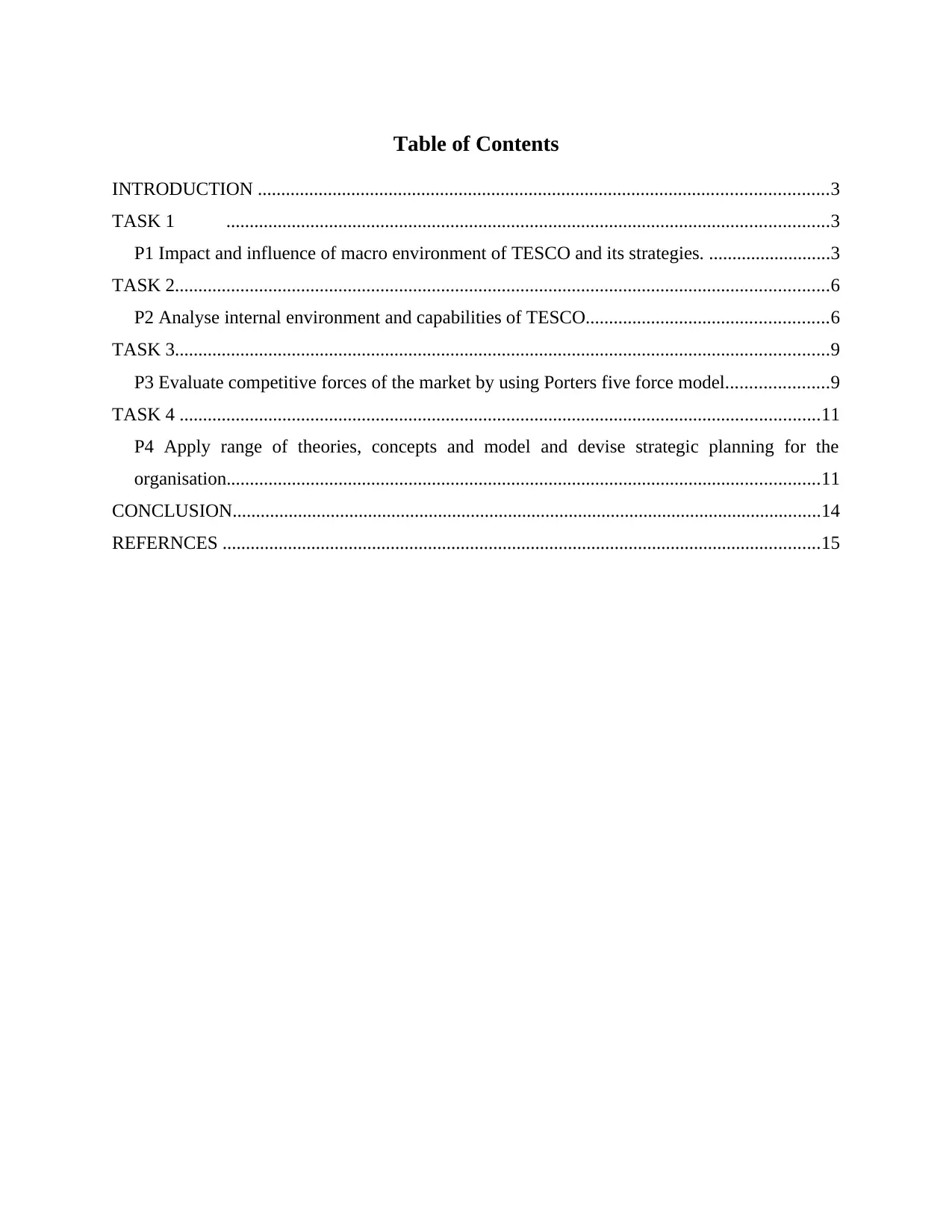
Table of Contents
INTRODUCTION ..........................................................................................................................3
TASK 1 .................................................................................................................................3
P1 Impact and influence of macro environment of TESCO and its strategies. ..........................3
TASK 2............................................................................................................................................6
P2 Analyse internal environment and capabilities of TESCO....................................................6
TASK 3............................................................................................................................................9
P3 Evaluate competitive forces of the market by using Porters five force model......................9
TASK 4 .........................................................................................................................................11
P4 Apply range of theories, concepts and model and devise strategic planning for the
organisation...............................................................................................................................11
CONCLUSION..............................................................................................................................14
REFERNCES ................................................................................................................................15
INTRODUCTION ..........................................................................................................................3
TASK 1 .................................................................................................................................3
P1 Impact and influence of macro environment of TESCO and its strategies. ..........................3
TASK 2............................................................................................................................................6
P2 Analyse internal environment and capabilities of TESCO....................................................6
TASK 3............................................................................................................................................9
P3 Evaluate competitive forces of the market by using Porters five force model......................9
TASK 4 .........................................................................................................................................11
P4 Apply range of theories, concepts and model and devise strategic planning for the
organisation...............................................................................................................................11
CONCLUSION..............................................................................................................................14
REFERNCES ................................................................................................................................15
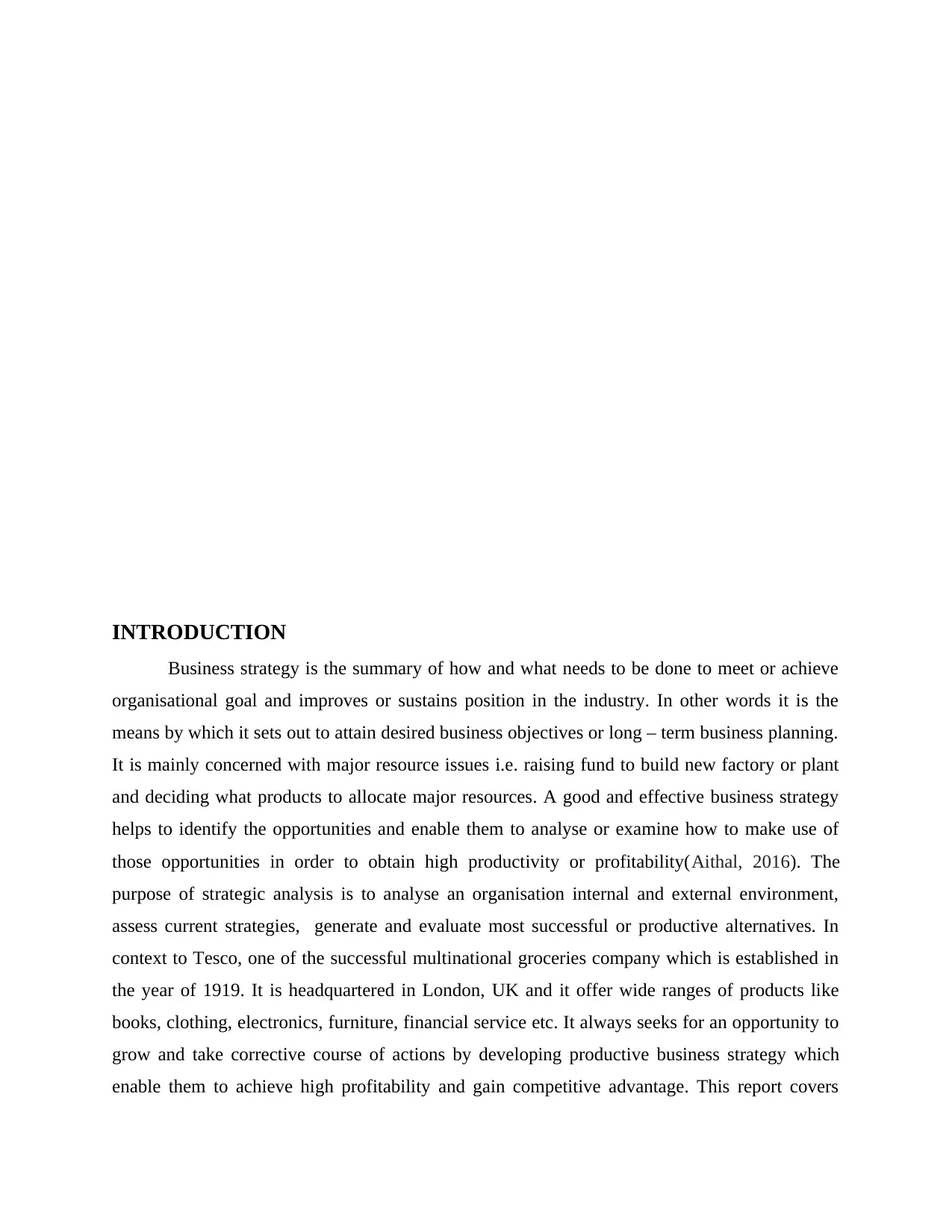
INTRODUCTION
Business strategy is the summary of how and what needs to be done to meet or achieve
organisational goal and improves or sustains position in the industry. In other words it is the
means by which it sets out to attain desired business objectives or long – term business planning.
It is mainly concerned with major resource issues i.e. raising fund to build new factory or plant
and deciding what products to allocate major resources. A good and effective business strategy
helps to identify the opportunities and enable them to analyse or examine how to make use of
those opportunities in order to obtain high productivity or profitability(Aithal, 2016). The
purpose of strategic analysis is to analyse an organisation internal and external environment,
assess current strategies, generate and evaluate most successful or productive alternatives. In
context to Tesco, one of the successful multinational groceries company which is established in
the year of 1919. It is headquartered in London, UK and it offer wide ranges of products like
books, clothing, electronics, furniture, financial service etc. It always seeks for an opportunity to
grow and take corrective course of actions by developing productive business strategy which
enable them to achieve high profitability and gain competitive advantage. This report covers
Business strategy is the summary of how and what needs to be done to meet or achieve
organisational goal and improves or sustains position in the industry. In other words it is the
means by which it sets out to attain desired business objectives or long – term business planning.
It is mainly concerned with major resource issues i.e. raising fund to build new factory or plant
and deciding what products to allocate major resources. A good and effective business strategy
helps to identify the opportunities and enable them to analyse or examine how to make use of
those opportunities in order to obtain high productivity or profitability(Aithal, 2016). The
purpose of strategic analysis is to analyse an organisation internal and external environment,
assess current strategies, generate and evaluate most successful or productive alternatives. In
context to Tesco, one of the successful multinational groceries company which is established in
the year of 1919. It is headquartered in London, UK and it offer wide ranges of products like
books, clothing, electronics, furniture, financial service etc. It always seeks for an opportunity to
grow and take corrective course of actions by developing productive business strategy which
enable them to achieve high profitability and gain competitive advantage. This report covers
⊘ This is a preview!⊘
Do you want full access?
Subscribe today to unlock all pages.

Trusted by 1+ million students worldwide
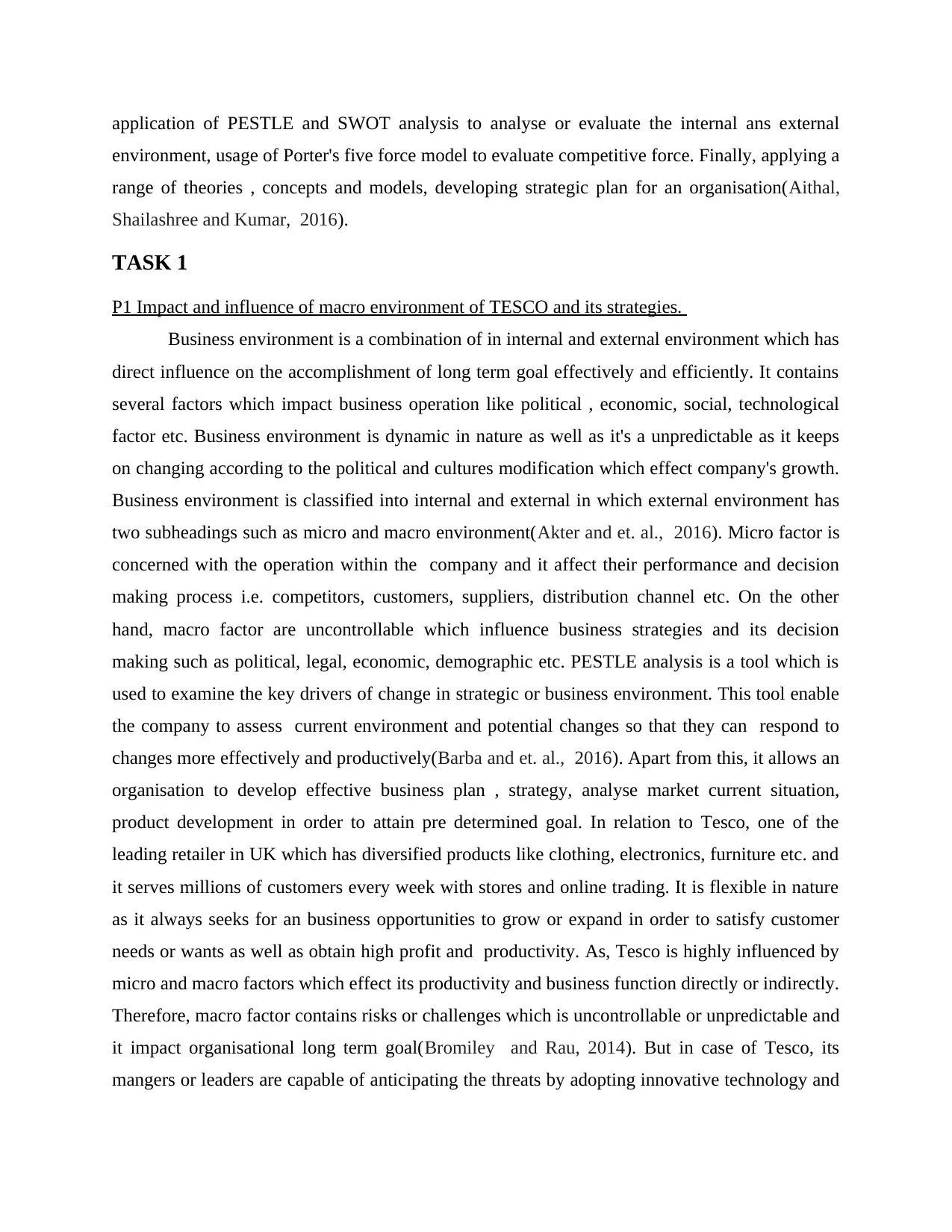
application of PESTLE and SWOT analysis to analyse or evaluate the internal ans external
environment, usage of Porter's five force model to evaluate competitive force. Finally, applying a
range of theories , concepts and models, developing strategic plan for an organisation(Aithal,
Shailashree and Kumar, 2016).
TASK 1
P1 Impact and influence of macro environment of TESCO and its strategies.
Business environment is a combination of in internal and external environment which has
direct influence on the accomplishment of long term goal effectively and efficiently. It contains
several factors which impact business operation like political , economic, social, technological
factor etc. Business environment is dynamic in nature as well as it's a unpredictable as it keeps
on changing according to the political and cultures modification which effect company's growth.
Business environment is classified into internal and external in which external environment has
two subheadings such as micro and macro environment(Akter and et. al., 2016). Micro factor is
concerned with the operation within the company and it affect their performance and decision
making process i.e. competitors, customers, suppliers, distribution channel etc. On the other
hand, macro factor are uncontrollable which influence business strategies and its decision
making such as political, legal, economic, demographic etc. PESTLE analysis is a tool which is
used to examine the key drivers of change in strategic or business environment. This tool enable
the company to assess current environment and potential changes so that they can respond to
changes more effectively and productively(Barba and et. al., 2016). Apart from this, it allows an
organisation to develop effective business plan , strategy, analyse market current situation,
product development in order to attain pre determined goal. In relation to Tesco, one of the
leading retailer in UK which has diversified products like clothing, electronics, furniture etc. and
it serves millions of customers every week with stores and online trading. It is flexible in nature
as it always seeks for an business opportunities to grow or expand in order to satisfy customer
needs or wants as well as obtain high profit and productivity. As, Tesco is highly influenced by
micro and macro factors which effect its productivity and business function directly or indirectly.
Therefore, macro factor contains risks or challenges which is uncontrollable or unpredictable and
it impact organisational long term goal(Bromiley and Rau, 2014). But in case of Tesco, its
mangers or leaders are capable of anticipating the threats by adopting innovative technology and
environment, usage of Porter's five force model to evaluate competitive force. Finally, applying a
range of theories , concepts and models, developing strategic plan for an organisation(Aithal,
Shailashree and Kumar, 2016).
TASK 1
P1 Impact and influence of macro environment of TESCO and its strategies.
Business environment is a combination of in internal and external environment which has
direct influence on the accomplishment of long term goal effectively and efficiently. It contains
several factors which impact business operation like political , economic, social, technological
factor etc. Business environment is dynamic in nature as well as it's a unpredictable as it keeps
on changing according to the political and cultures modification which effect company's growth.
Business environment is classified into internal and external in which external environment has
two subheadings such as micro and macro environment(Akter and et. al., 2016). Micro factor is
concerned with the operation within the company and it affect their performance and decision
making process i.e. competitors, customers, suppliers, distribution channel etc. On the other
hand, macro factor are uncontrollable which influence business strategies and its decision
making such as political, legal, economic, demographic etc. PESTLE analysis is a tool which is
used to examine the key drivers of change in strategic or business environment. This tool enable
the company to assess current environment and potential changes so that they can respond to
changes more effectively and productively(Barba and et. al., 2016). Apart from this, it allows an
organisation to develop effective business plan , strategy, analyse market current situation,
product development in order to attain pre determined goal. In relation to Tesco, one of the
leading retailer in UK which has diversified products like clothing, electronics, furniture etc. and
it serves millions of customers every week with stores and online trading. It is flexible in nature
as it always seeks for an business opportunities to grow or expand in order to satisfy customer
needs or wants as well as obtain high profit and productivity. As, Tesco is highly influenced by
micro and macro factors which effect its productivity and business function directly or indirectly.
Therefore, macro factor contains risks or challenges which is uncontrollable or unpredictable and
it impact organisational long term goal(Bromiley and Rau, 2014). But in case of Tesco, its
mangers or leaders are capable of anticipating the threats by adopting innovative technology and
Paraphrase This Document
Need a fresh take? Get an instant paraphrase of this document with our AI Paraphraser
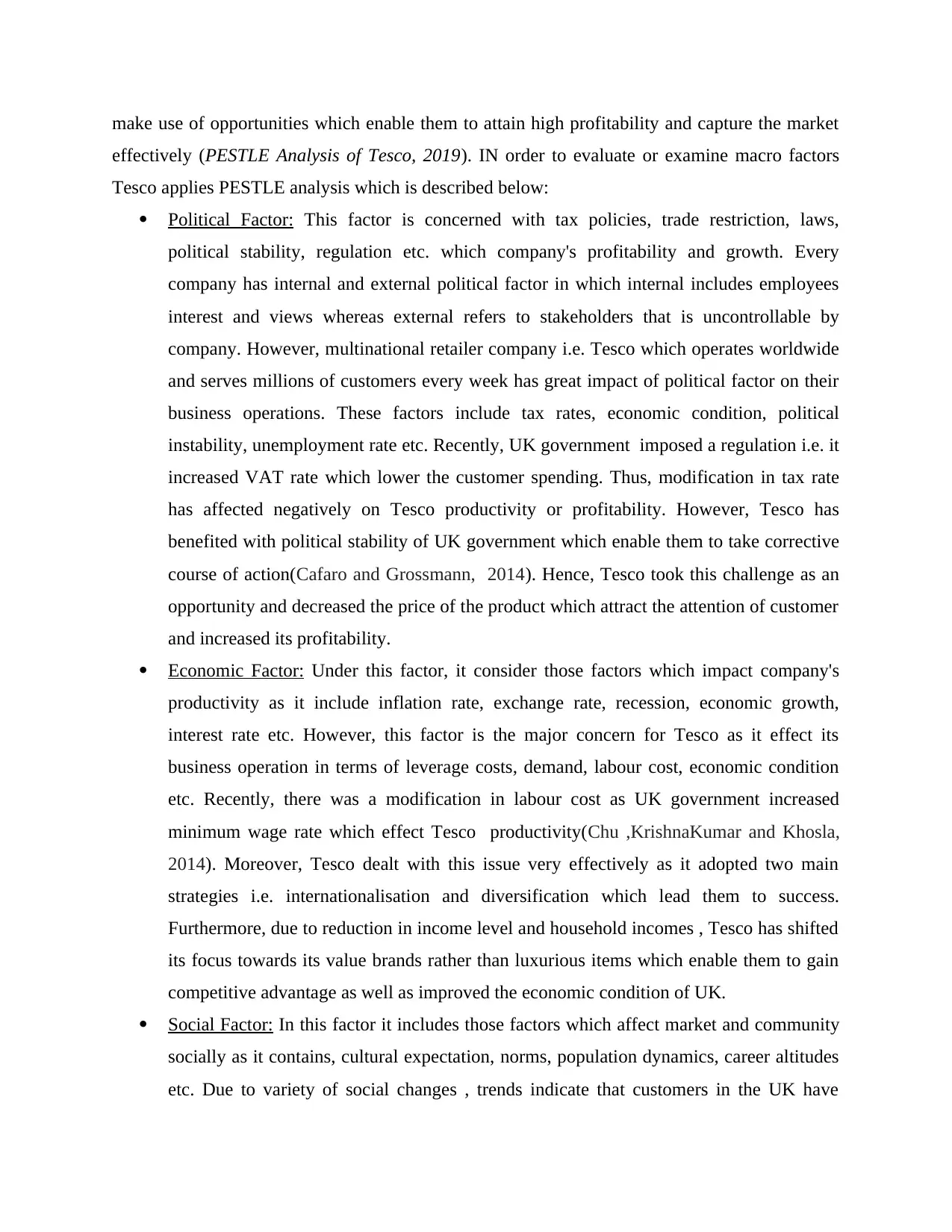
make use of opportunities which enable them to attain high profitability and capture the market
effectively (PESTLE Analysis of Tesco, 2019). IN order to evaluate or examine macro factors
Tesco applies PESTLE analysis which is described below:
Political Factor: This factor is concerned with tax policies, trade restriction, laws,
political stability, regulation etc. which company's profitability and growth. Every
company has internal and external political factor in which internal includes employees
interest and views whereas external refers to stakeholders that is uncontrollable by
company. However, multinational retailer company i.e. Tesco which operates worldwide
and serves millions of customers every week has great impact of political factor on their
business operations. These factors include tax rates, economic condition, political
instability, unemployment rate etc. Recently, UK government imposed a regulation i.e. it
increased VAT rate which lower the customer spending. Thus, modification in tax rate
has affected negatively on Tesco productivity or profitability. However, Tesco has
benefited with political stability of UK government which enable them to take corrective
course of action(Cafaro and Grossmann, 2014). Hence, Tesco took this challenge as an
opportunity and decreased the price of the product which attract the attention of customer
and increased its profitability.
Economic Factor: Under this factor, it consider those factors which impact company's
productivity as it include inflation rate, exchange rate, recession, economic growth,
interest rate etc. However, this factor is the major concern for Tesco as it effect its
business operation in terms of leverage costs, demand, labour cost, economic condition
etc. Recently, there was a modification in labour cost as UK government increased
minimum wage rate which effect Tesco productivity(Chu ,KrishnaKumar and Khosla,
2014). Moreover, Tesco dealt with this issue very effectively as it adopted two main
strategies i.e. internationalisation and diversification which lead them to success.
Furthermore, due to reduction in income level and household incomes , Tesco has shifted
its focus towards its value brands rather than luxurious items which enable them to gain
competitive advantage as well as improved the economic condition of UK.
Social Factor: In this factor it includes those factors which affect market and community
socially as it contains, cultural expectation, norms, population dynamics, career altitudes
etc. Due to variety of social changes , trends indicate that customers in the UK have
effectively (PESTLE Analysis of Tesco, 2019). IN order to evaluate or examine macro factors
Tesco applies PESTLE analysis which is described below:
Political Factor: This factor is concerned with tax policies, trade restriction, laws,
political stability, regulation etc. which company's profitability and growth. Every
company has internal and external political factor in which internal includes employees
interest and views whereas external refers to stakeholders that is uncontrollable by
company. However, multinational retailer company i.e. Tesco which operates worldwide
and serves millions of customers every week has great impact of political factor on their
business operations. These factors include tax rates, economic condition, political
instability, unemployment rate etc. Recently, UK government imposed a regulation i.e. it
increased VAT rate which lower the customer spending. Thus, modification in tax rate
has affected negatively on Tesco productivity or profitability. However, Tesco has
benefited with political stability of UK government which enable them to take corrective
course of action(Cafaro and Grossmann, 2014). Hence, Tesco took this challenge as an
opportunity and decreased the price of the product which attract the attention of customer
and increased its profitability.
Economic Factor: Under this factor, it consider those factors which impact company's
productivity as it include inflation rate, exchange rate, recession, economic growth,
interest rate etc. However, this factor is the major concern for Tesco as it effect its
business operation in terms of leverage costs, demand, labour cost, economic condition
etc. Recently, there was a modification in labour cost as UK government increased
minimum wage rate which effect Tesco productivity(Chu ,KrishnaKumar and Khosla,
2014). Moreover, Tesco dealt with this issue very effectively as it adopted two main
strategies i.e. internationalisation and diversification which lead them to success.
Furthermore, due to reduction in income level and household incomes , Tesco has shifted
its focus towards its value brands rather than luxurious items which enable them to gain
competitive advantage as well as improved the economic condition of UK.
Social Factor: In this factor it includes those factors which affect market and community
socially as it contains, cultural expectation, norms, population dynamics, career altitudes
etc. Due to variety of social changes , trends indicate that customers in the UK have
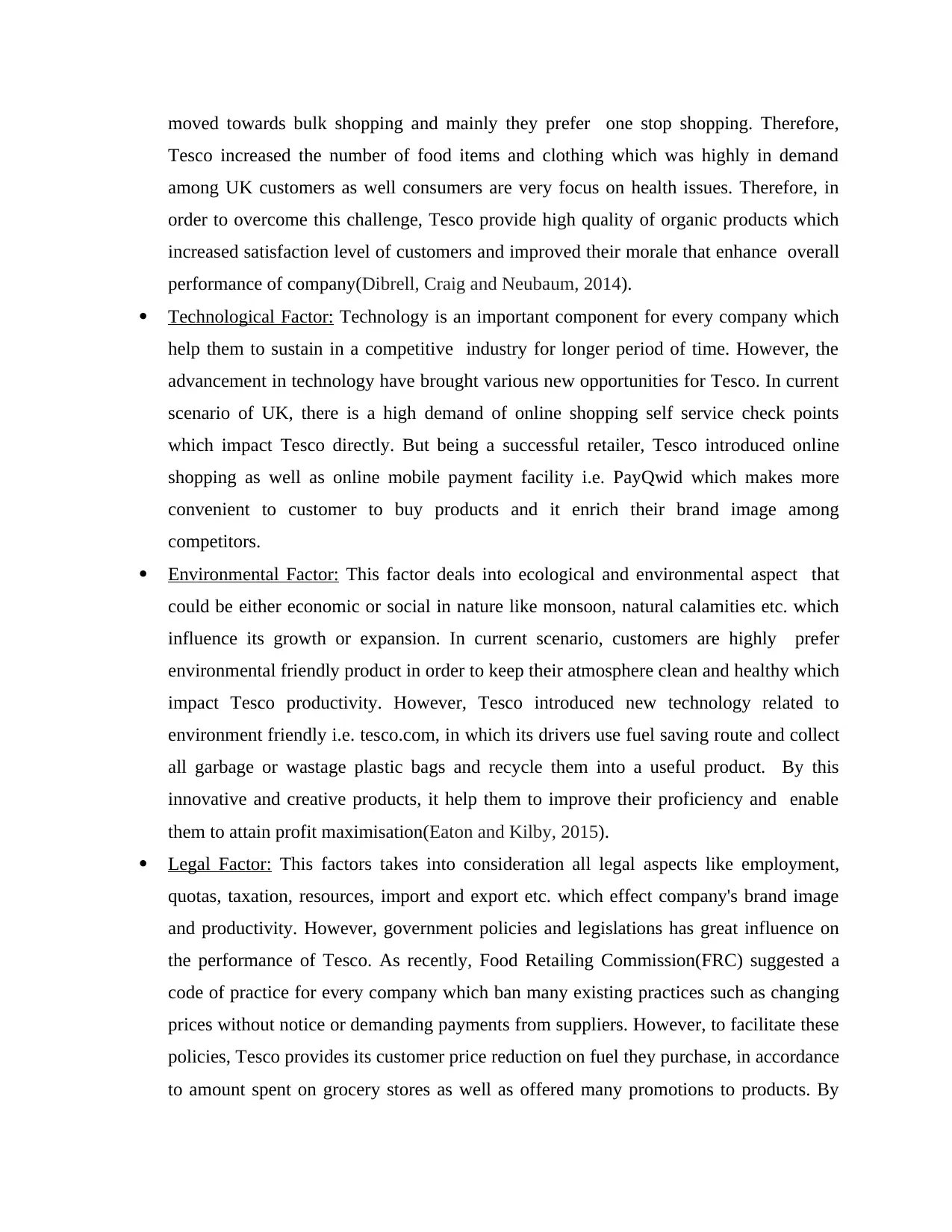
moved towards bulk shopping and mainly they prefer one stop shopping. Therefore,
Tesco increased the number of food items and clothing which was highly in demand
among UK customers as well consumers are very focus on health issues. Therefore, in
order to overcome this challenge, Tesco provide high quality of organic products which
increased satisfaction level of customers and improved their morale that enhance overall
performance of company(Dibrell, Craig and Neubaum, 2014).
Technological Factor: Technology is an important component for every company which
help them to sustain in a competitive industry for longer period of time. However, the
advancement in technology have brought various new opportunities for Tesco. In current
scenario of UK, there is a high demand of online shopping self service check points
which impact Tesco directly. But being a successful retailer, Tesco introduced online
shopping as well as online mobile payment facility i.e. PayQwid which makes more
convenient to customer to buy products and it enrich their brand image among
competitors.
Environmental Factor: This factor deals into ecological and environmental aspect that
could be either economic or social in nature like monsoon, natural calamities etc. which
influence its growth or expansion. In current scenario, customers are highly prefer
environmental friendly product in order to keep their atmosphere clean and healthy which
impact Tesco productivity. However, Tesco introduced new technology related to
environment friendly i.e. tesco.com, in which its drivers use fuel saving route and collect
all garbage or wastage plastic bags and recycle them into a useful product. By this
innovative and creative products, it help them to improve their proficiency and enable
them to attain profit maximisation(Eaton and Kilby, 2015).
Legal Factor: This factors takes into consideration all legal aspects like employment,
quotas, taxation, resources, import and export etc. which effect company's brand image
and productivity. However, government policies and legislations has great influence on
the performance of Tesco. As recently, Food Retailing Commission(FRC) suggested a
code of practice for every company which ban many existing practices such as changing
prices without notice or demanding payments from suppliers. However, to facilitate these
policies, Tesco provides its customer price reduction on fuel they purchase, in accordance
to amount spent on grocery stores as well as offered many promotions to products. By
Tesco increased the number of food items and clothing which was highly in demand
among UK customers as well consumers are very focus on health issues. Therefore, in
order to overcome this challenge, Tesco provide high quality of organic products which
increased satisfaction level of customers and improved their morale that enhance overall
performance of company(Dibrell, Craig and Neubaum, 2014).
Technological Factor: Technology is an important component for every company which
help them to sustain in a competitive industry for longer period of time. However, the
advancement in technology have brought various new opportunities for Tesco. In current
scenario of UK, there is a high demand of online shopping self service check points
which impact Tesco directly. But being a successful retailer, Tesco introduced online
shopping as well as online mobile payment facility i.e. PayQwid which makes more
convenient to customer to buy products and it enrich their brand image among
competitors.
Environmental Factor: This factor deals into ecological and environmental aspect that
could be either economic or social in nature like monsoon, natural calamities etc. which
influence its growth or expansion. In current scenario, customers are highly prefer
environmental friendly product in order to keep their atmosphere clean and healthy which
impact Tesco productivity. However, Tesco introduced new technology related to
environment friendly i.e. tesco.com, in which its drivers use fuel saving route and collect
all garbage or wastage plastic bags and recycle them into a useful product. By this
innovative and creative products, it help them to improve their proficiency and enable
them to attain profit maximisation(Eaton and Kilby, 2015).
Legal Factor: This factors takes into consideration all legal aspects like employment,
quotas, taxation, resources, import and export etc. which effect company's brand image
and productivity. However, government policies and legislations has great influence on
the performance of Tesco. As recently, Food Retailing Commission(FRC) suggested a
code of practice for every company which ban many existing practices such as changing
prices without notice or demanding payments from suppliers. However, to facilitate these
policies, Tesco provides its customer price reduction on fuel they purchase, in accordance
to amount spent on grocery stores as well as offered many promotions to products. By
⊘ This is a preview!⊘
Do you want full access?
Subscribe today to unlock all pages.

Trusted by 1+ million students worldwide
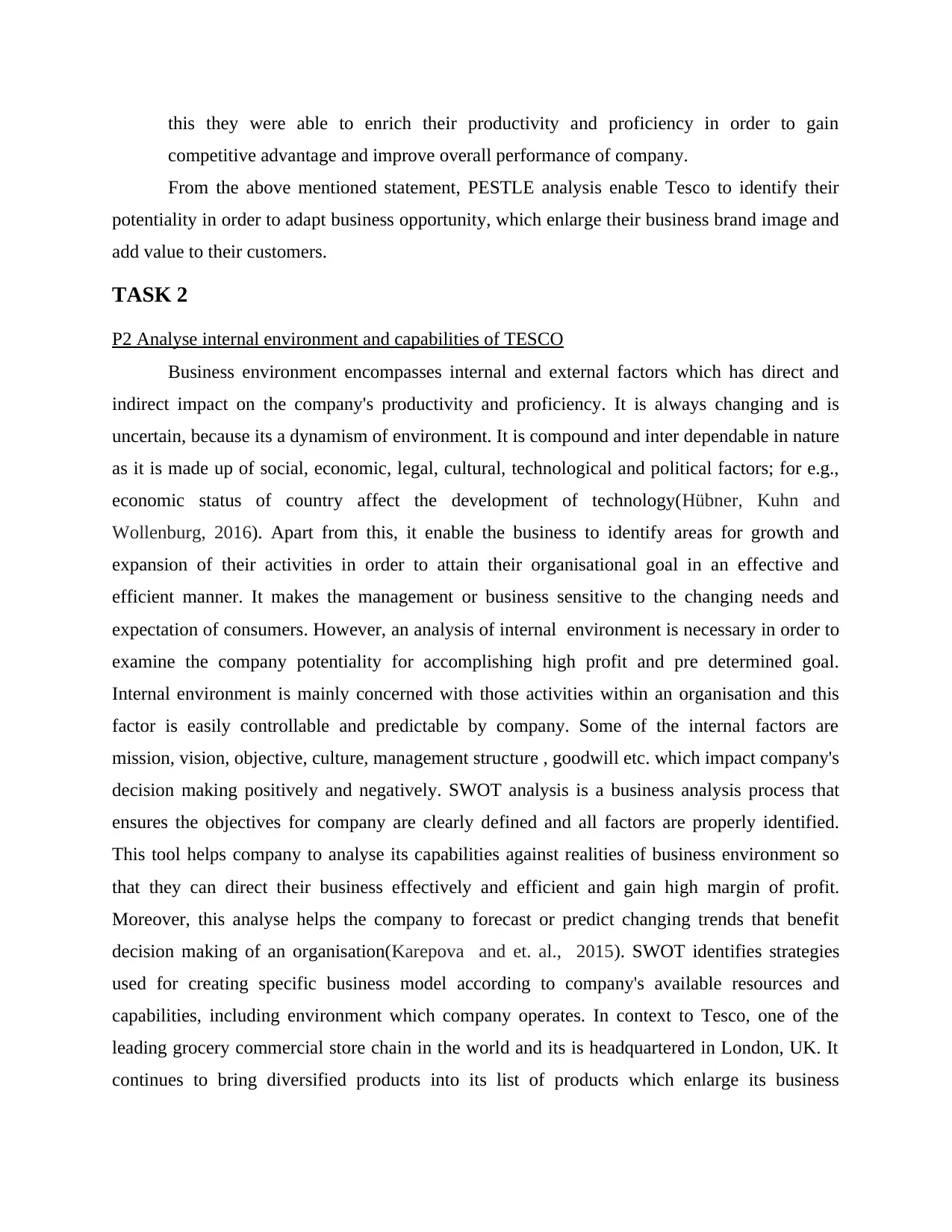
this they were able to enrich their productivity and proficiency in order to gain
competitive advantage and improve overall performance of company.
From the above mentioned statement, PESTLE analysis enable Tesco to identify their
potentiality in order to adapt business opportunity, which enlarge their business brand image and
add value to their customers.
TASK 2
P2 Analyse internal environment and capabilities of TESCO
Business environment encompasses internal and external factors which has direct and
indirect impact on the company's productivity and proficiency. It is always changing and is
uncertain, because its a dynamism of environment. It is compound and inter dependable in nature
as it is made up of social, economic, legal, cultural, technological and political factors; for e.g.,
economic status of country affect the development of technology(Hübner, Kuhn and
Wollenburg, 2016). Apart from this, it enable the business to identify areas for growth and
expansion of their activities in order to attain their organisational goal in an effective and
efficient manner. It makes the management or business sensitive to the changing needs and
expectation of consumers. However, an analysis of internal environment is necessary in order to
examine the company potentiality for accomplishing high profit and pre determined goal.
Internal environment is mainly concerned with those activities within an organisation and this
factor is easily controllable and predictable by company. Some of the internal factors are
mission, vision, objective, culture, management structure , goodwill etc. which impact company's
decision making positively and negatively. SWOT analysis is a business analysis process that
ensures the objectives for company are clearly defined and all factors are properly identified.
This tool helps company to analyse its capabilities against realities of business environment so
that they can direct their business effectively and efficient and gain high margin of profit.
Moreover, this analyse helps the company to forecast or predict changing trends that benefit
decision making of an organisation(Karepova and et. al., 2015). SWOT identifies strategies
used for creating specific business model according to company's available resources and
capabilities, including environment which company operates. In context to Tesco, one of the
leading grocery commercial store chain in the world and its is headquartered in London, UK. It
continues to bring diversified products into its list of products which enlarge its business
competitive advantage and improve overall performance of company.
From the above mentioned statement, PESTLE analysis enable Tesco to identify their
potentiality in order to adapt business opportunity, which enlarge their business brand image and
add value to their customers.
TASK 2
P2 Analyse internal environment and capabilities of TESCO
Business environment encompasses internal and external factors which has direct and
indirect impact on the company's productivity and proficiency. It is always changing and is
uncertain, because its a dynamism of environment. It is compound and inter dependable in nature
as it is made up of social, economic, legal, cultural, technological and political factors; for e.g.,
economic status of country affect the development of technology(Hübner, Kuhn and
Wollenburg, 2016). Apart from this, it enable the business to identify areas for growth and
expansion of their activities in order to attain their organisational goal in an effective and
efficient manner. It makes the management or business sensitive to the changing needs and
expectation of consumers. However, an analysis of internal environment is necessary in order to
examine the company potentiality for accomplishing high profit and pre determined goal.
Internal environment is mainly concerned with those activities within an organisation and this
factor is easily controllable and predictable by company. Some of the internal factors are
mission, vision, objective, culture, management structure , goodwill etc. which impact company's
decision making positively and negatively. SWOT analysis is a business analysis process that
ensures the objectives for company are clearly defined and all factors are properly identified.
This tool helps company to analyse its capabilities against realities of business environment so
that they can direct their business effectively and efficient and gain high margin of profit.
Moreover, this analyse helps the company to forecast or predict changing trends that benefit
decision making of an organisation(Karepova and et. al., 2015). SWOT identifies strategies
used for creating specific business model according to company's available resources and
capabilities, including environment which company operates. In context to Tesco, one of the
leading grocery commercial store chain in the world and its is headquartered in London, UK. It
continues to bring diversified products into its list of products which enlarge its business
Paraphrase This Document
Need a fresh take? Get an instant paraphrase of this document with our AI Paraphraser
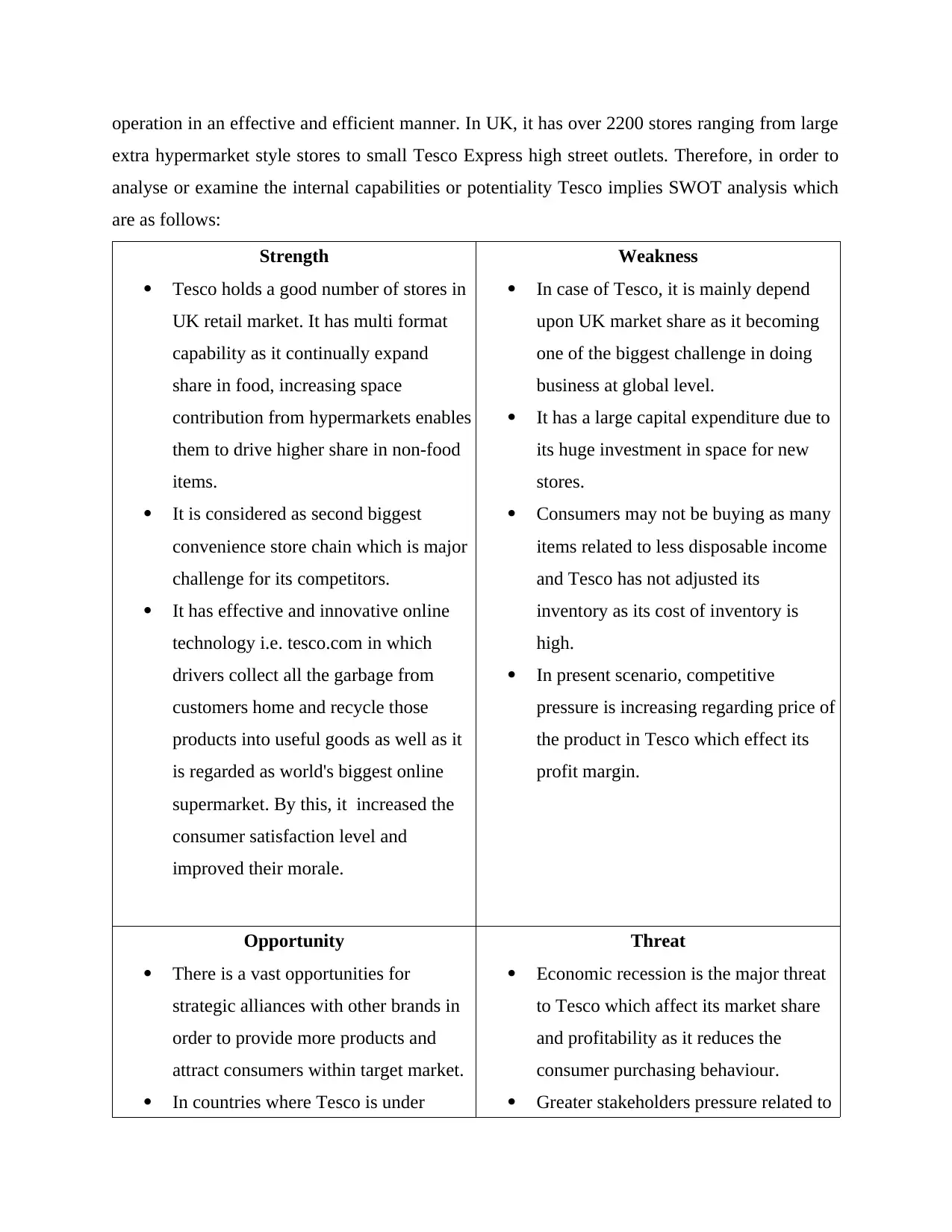
operation in an effective and efficient manner. In UK, it has over 2200 stores ranging from large
extra hypermarket style stores to small Tesco Express high street outlets. Therefore, in order to
analyse or examine the internal capabilities or potentiality Tesco implies SWOT analysis which
are as follows:
Strength
Tesco holds a good number of stores in
UK retail market. It has multi format
capability as it continually expand
share in food, increasing space
contribution from hypermarkets enables
them to drive higher share in non-food
items.
It is considered as second biggest
convenience store chain which is major
challenge for its competitors.
It has effective and innovative online
technology i.e. tesco.com in which
drivers collect all the garbage from
customers home and recycle those
products into useful goods as well as it
is regarded as world's biggest online
supermarket. By this, it increased the
consumer satisfaction level and
improved their morale.
Weakness
In case of Tesco, it is mainly depend
upon UK market share as it becoming
one of the biggest challenge in doing
business at global level.
It has a large capital expenditure due to
its huge investment in space for new
stores.
Consumers may not be buying as many
items related to less disposable income
and Tesco has not adjusted its
inventory as its cost of inventory is
high.
In present scenario, competitive
pressure is increasing regarding price of
the product in Tesco which effect its
profit margin.
Opportunity
There is a vast opportunities for
strategic alliances with other brands in
order to provide more products and
attract consumers within target market.
In countries where Tesco is under
Threat
Economic recession is the major threat
to Tesco which affect its market share
and profitability as it reduces the
consumer purchasing behaviour.
Greater stakeholders pressure related to
extra hypermarket style stores to small Tesco Express high street outlets. Therefore, in order to
analyse or examine the internal capabilities or potentiality Tesco implies SWOT analysis which
are as follows:
Strength
Tesco holds a good number of stores in
UK retail market. It has multi format
capability as it continually expand
share in food, increasing space
contribution from hypermarkets enables
them to drive higher share in non-food
items.
It is considered as second biggest
convenience store chain which is major
challenge for its competitors.
It has effective and innovative online
technology i.e. tesco.com in which
drivers collect all the garbage from
customers home and recycle those
products into useful goods as well as it
is regarded as world's biggest online
supermarket. By this, it increased the
consumer satisfaction level and
improved their morale.
Weakness
In case of Tesco, it is mainly depend
upon UK market share as it becoming
one of the biggest challenge in doing
business at global level.
It has a large capital expenditure due to
its huge investment in space for new
stores.
Consumers may not be buying as many
items related to less disposable income
and Tesco has not adjusted its
inventory as its cost of inventory is
high.
In present scenario, competitive
pressure is increasing regarding price of
the product in Tesco which effect its
profit margin.
Opportunity
There is a vast opportunities for
strategic alliances with other brands in
order to provide more products and
attract consumers within target market.
In countries where Tesco is under
Threat
Economic recession is the major threat
to Tesco which affect its market share
and profitability as it reduces the
consumer purchasing behaviour.
Greater stakeholders pressure related to
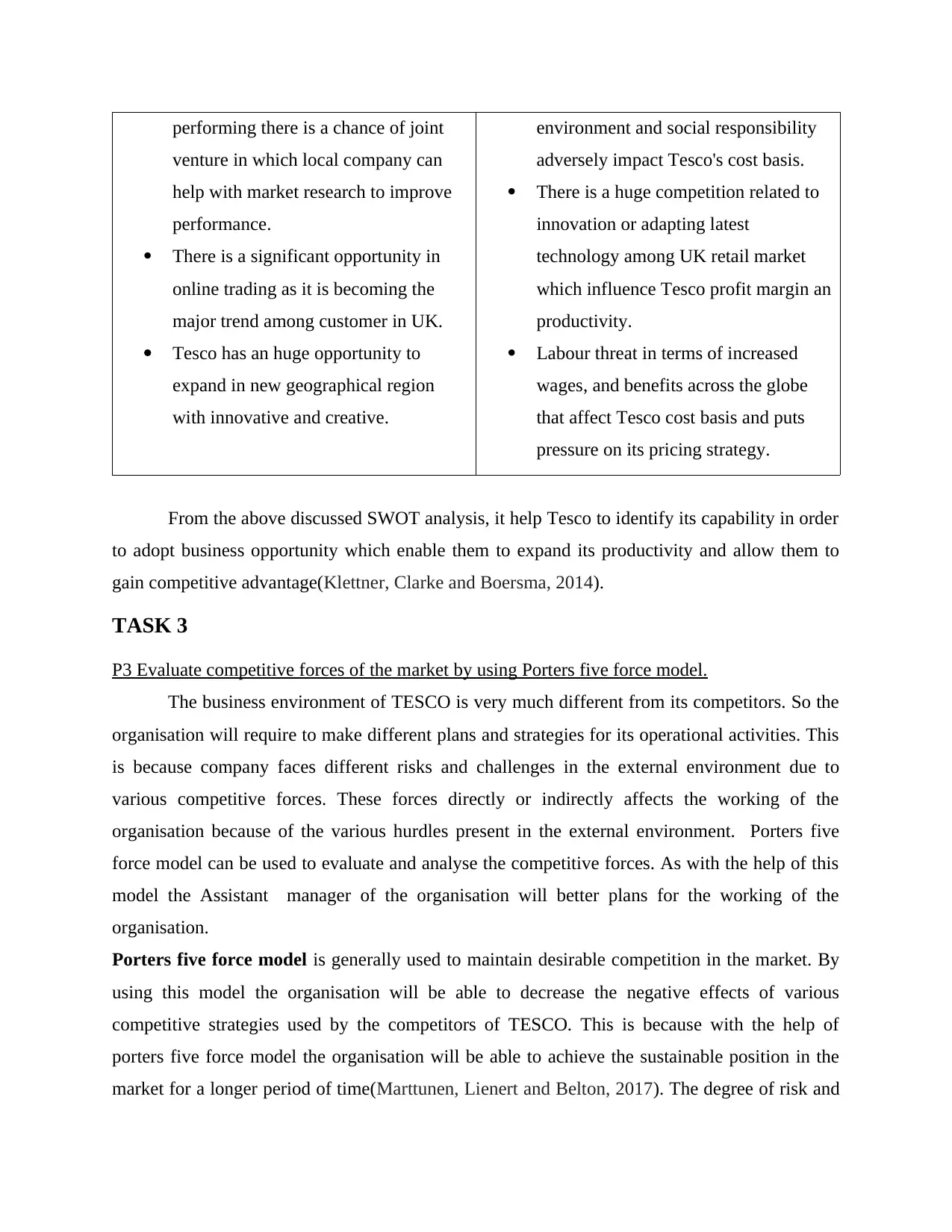
performing there is a chance of joint
venture in which local company can
help with market research to improve
performance.
There is a significant opportunity in
online trading as it is becoming the
major trend among customer in UK.
Tesco has an huge opportunity to
expand in new geographical region
with innovative and creative.
environment and social responsibility
adversely impact Tesco's cost basis.
There is a huge competition related to
innovation or adapting latest
technology among UK retail market
which influence Tesco profit margin an
productivity.
Labour threat in terms of increased
wages, and benefits across the globe
that affect Tesco cost basis and puts
pressure on its pricing strategy.
From the above discussed SWOT analysis, it help Tesco to identify its capability in order
to adopt business opportunity which enable them to expand its productivity and allow them to
gain competitive advantage(Klettner, Clarke and Boersma, 2014).
TASK 3
P3 Evaluate competitive forces of the market by using Porters five force model.
The business environment of TESCO is very much different from its competitors. So the
organisation will require to make different plans and strategies for its operational activities. This
is because company faces different risks and challenges in the external environment due to
various competitive forces. These forces directly or indirectly affects the working of the
organisation because of the various hurdles present in the external environment. Porters five
force model can be used to evaluate and analyse the competitive forces. As with the help of this
model the Assistant manager of the organisation will better plans for the working of the
organisation.
Porters five force model is generally used to maintain desirable competition in the market. By
using this model the organisation will be able to decrease the negative effects of various
competitive strategies used by the competitors of TESCO. This is because with the help of
porters five force model the organisation will be able to achieve the sustainable position in the
market for a longer period of time(Marttunen, Lienert and Belton, 2017). The degree of risk and
venture in which local company can
help with market research to improve
performance.
There is a significant opportunity in
online trading as it is becoming the
major trend among customer in UK.
Tesco has an huge opportunity to
expand in new geographical region
with innovative and creative.
environment and social responsibility
adversely impact Tesco's cost basis.
There is a huge competition related to
innovation or adapting latest
technology among UK retail market
which influence Tesco profit margin an
productivity.
Labour threat in terms of increased
wages, and benefits across the globe
that affect Tesco cost basis and puts
pressure on its pricing strategy.
From the above discussed SWOT analysis, it help Tesco to identify its capability in order
to adopt business opportunity which enable them to expand its productivity and allow them to
gain competitive advantage(Klettner, Clarke and Boersma, 2014).
TASK 3
P3 Evaluate competitive forces of the market by using Porters five force model.
The business environment of TESCO is very much different from its competitors. So the
organisation will require to make different plans and strategies for its operational activities. This
is because company faces different risks and challenges in the external environment due to
various competitive forces. These forces directly or indirectly affects the working of the
organisation because of the various hurdles present in the external environment. Porters five
force model can be used to evaluate and analyse the competitive forces. As with the help of this
model the Assistant manager of the organisation will better plans for the working of the
organisation.
Porters five force model is generally used to maintain desirable competition in the market. By
using this model the organisation will be able to decrease the negative effects of various
competitive strategies used by the competitors of TESCO. This is because with the help of
porters five force model the organisation will be able to achieve the sustainable position in the
market for a longer period of time(Marttunen, Lienert and Belton, 2017). The degree of risk and
⊘ This is a preview!⊘
Do you want full access?
Subscribe today to unlock all pages.

Trusted by 1+ million students worldwide
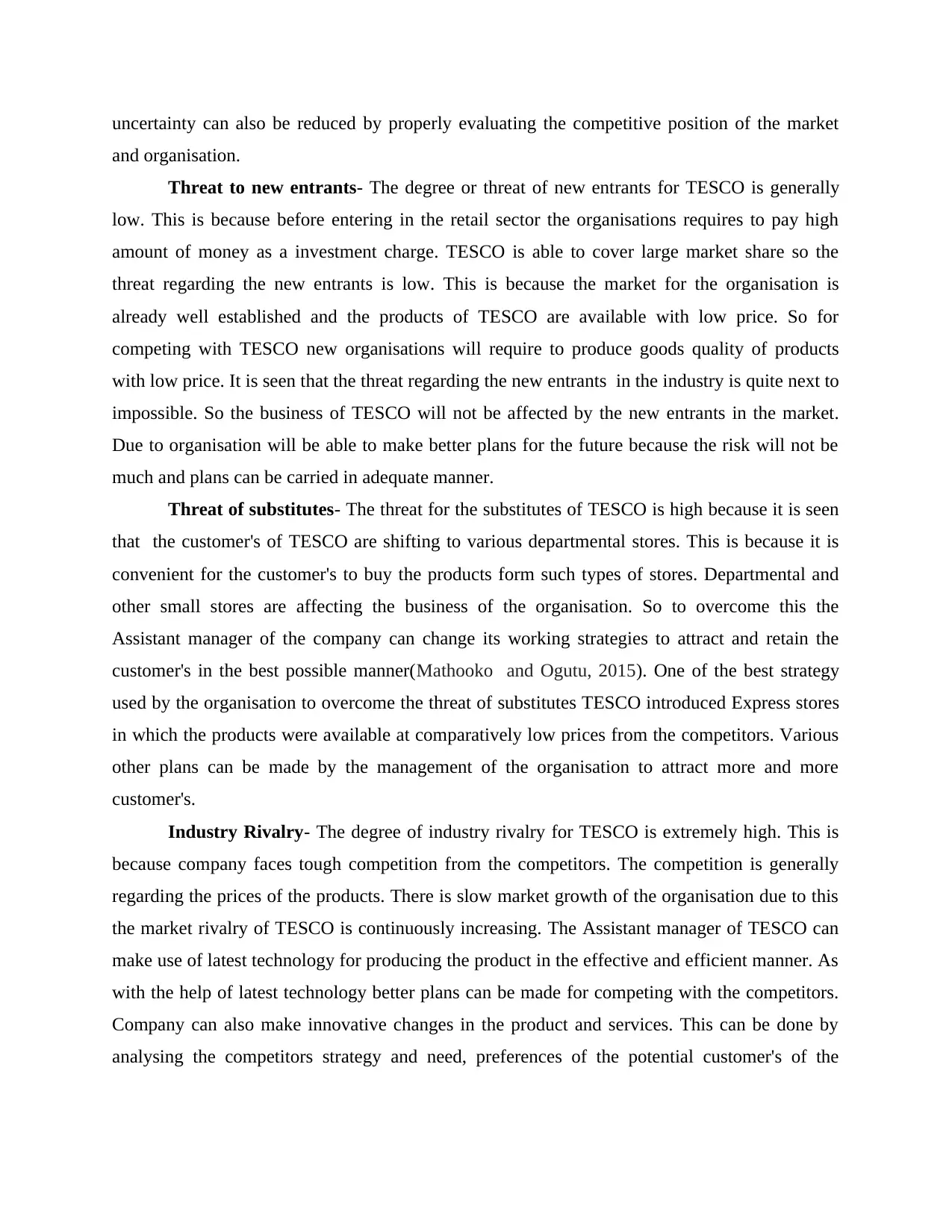
uncertainty can also be reduced by properly evaluating the competitive position of the market
and organisation.
Threat to new entrants- The degree or threat of new entrants for TESCO is generally
low. This is because before entering in the retail sector the organisations requires to pay high
amount of money as a investment charge. TESCO is able to cover large market share so the
threat regarding the new entrants is low. This is because the market for the organisation is
already well established and the products of TESCO are available with low price. So for
competing with TESCO new organisations will require to produce goods quality of products
with low price. It is seen that the threat regarding the new entrants in the industry is quite next to
impossible. So the business of TESCO will not be affected by the new entrants in the market.
Due to organisation will be able to make better plans for the future because the risk will not be
much and plans can be carried in adequate manner.
Threat of substitutes- The threat for the substitutes of TESCO is high because it is seen
that the customer's of TESCO are shifting to various departmental stores. This is because it is
convenient for the customer's to buy the products form such types of stores. Departmental and
other small stores are affecting the business of the organisation. So to overcome this the
Assistant manager of the company can change its working strategies to attract and retain the
customer's in the best possible manner(Mathooko and Ogutu, 2015). One of the best strategy
used by the organisation to overcome the threat of substitutes TESCO introduced Express stores
in which the products were available at comparatively low prices from the competitors. Various
other plans can be made by the management of the organisation to attract more and more
customer's.
Industry Rivalry- The degree of industry rivalry for TESCO is extremely high. This is
because company faces tough competition from the competitors. The competition is generally
regarding the prices of the products. There is slow market growth of the organisation due to this
the market rivalry of TESCO is continuously increasing. The Assistant manager of TESCO can
make use of latest technology for producing the product in the effective and efficient manner. As
with the help of latest technology better plans can be made for competing with the competitors.
Company can also make innovative changes in the product and services. This can be done by
analysing the competitors strategy and need, preferences of the potential customer's of the
and organisation.
Threat to new entrants- The degree or threat of new entrants for TESCO is generally
low. This is because before entering in the retail sector the organisations requires to pay high
amount of money as a investment charge. TESCO is able to cover large market share so the
threat regarding the new entrants is low. This is because the market for the organisation is
already well established and the products of TESCO are available with low price. So for
competing with TESCO new organisations will require to produce goods quality of products
with low price. It is seen that the threat regarding the new entrants in the industry is quite next to
impossible. So the business of TESCO will not be affected by the new entrants in the market.
Due to organisation will be able to make better plans for the future because the risk will not be
much and plans can be carried in adequate manner.
Threat of substitutes- The threat for the substitutes of TESCO is high because it is seen
that the customer's of TESCO are shifting to various departmental stores. This is because it is
convenient for the customer's to buy the products form such types of stores. Departmental and
other small stores are affecting the business of the organisation. So to overcome this the
Assistant manager of the company can change its working strategies to attract and retain the
customer's in the best possible manner(Mathooko and Ogutu, 2015). One of the best strategy
used by the organisation to overcome the threat of substitutes TESCO introduced Express stores
in which the products were available at comparatively low prices from the competitors. Various
other plans can be made by the management of the organisation to attract more and more
customer's.
Industry Rivalry- The degree of industry rivalry for TESCO is extremely high. This is
because company faces tough competition from the competitors. The competition is generally
regarding the prices of the products. There is slow market growth of the organisation due to this
the market rivalry of TESCO is continuously increasing. The Assistant manager of TESCO can
make use of latest technology for producing the product in the effective and efficient manner. As
with the help of latest technology better plans can be made for competing with the competitors.
Company can also make innovative changes in the product and services. This can be done by
analysing the competitors strategy and need, preferences of the potential customer's of the
Paraphrase This Document
Need a fresh take? Get an instant paraphrase of this document with our AI Paraphraser
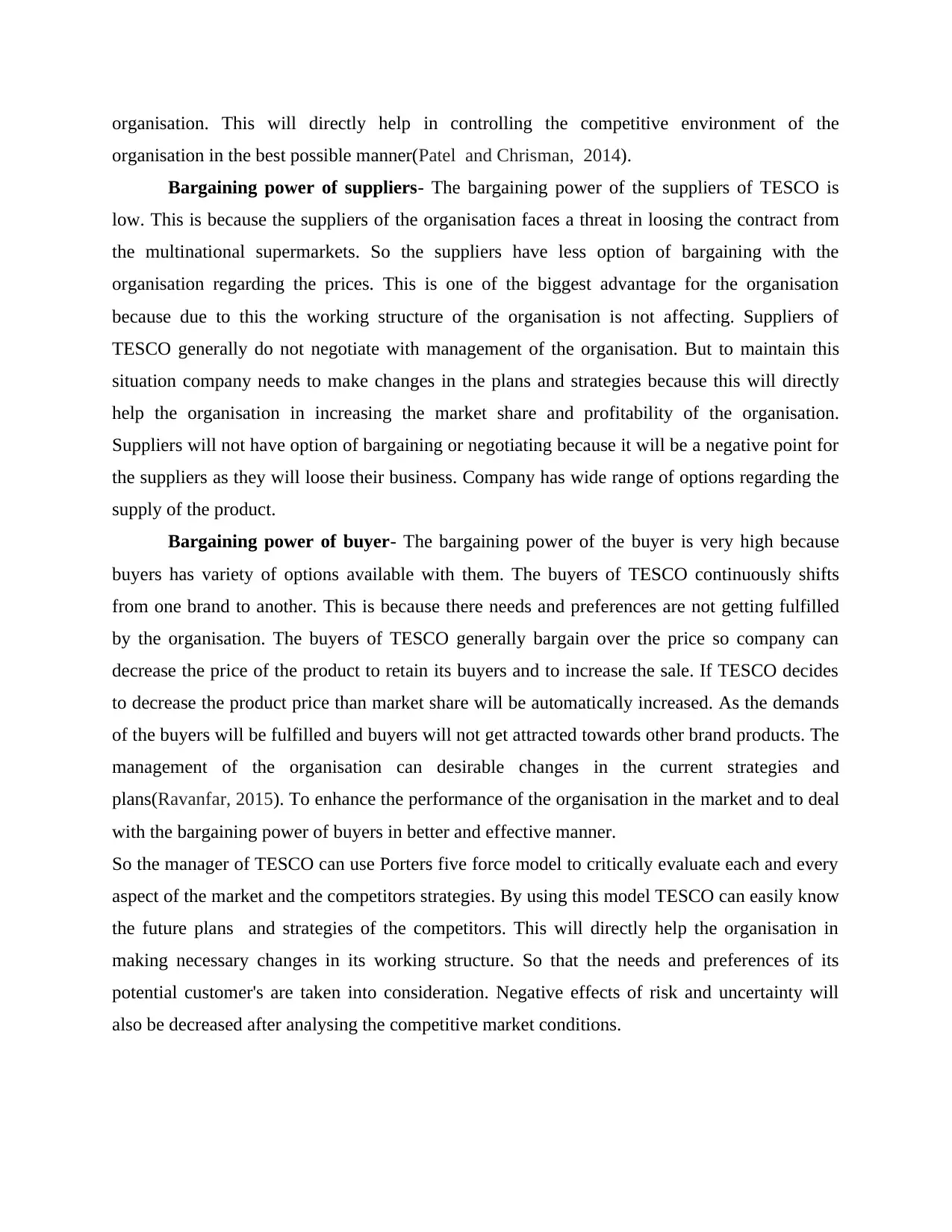
organisation. This will directly help in controlling the competitive environment of the
organisation in the best possible manner(Patel and Chrisman, 2014).
Bargaining power of suppliers- The bargaining power of the suppliers of TESCO is
low. This is because the suppliers of the organisation faces a threat in loosing the contract from
the multinational supermarkets. So the suppliers have less option of bargaining with the
organisation regarding the prices. This is one of the biggest advantage for the organisation
because due to this the working structure of the organisation is not affecting. Suppliers of
TESCO generally do not negotiate with management of the organisation. But to maintain this
situation company needs to make changes in the plans and strategies because this will directly
help the organisation in increasing the market share and profitability of the organisation.
Suppliers will not have option of bargaining or negotiating because it will be a negative point for
the suppliers as they will loose their business. Company has wide range of options regarding the
supply of the product.
Bargaining power of buyer- The bargaining power of the buyer is very high because
buyers has variety of options available with them. The buyers of TESCO continuously shifts
from one brand to another. This is because there needs and preferences are not getting fulfilled
by the organisation. The buyers of TESCO generally bargain over the price so company can
decrease the price of the product to retain its buyers and to increase the sale. If TESCO decides
to decrease the product price than market share will be automatically increased. As the demands
of the buyers will be fulfilled and buyers will not get attracted towards other brand products. The
management of the organisation can desirable changes in the current strategies and
plans(Ravanfar, 2015). To enhance the performance of the organisation in the market and to deal
with the bargaining power of buyers in better and effective manner.
So the manager of TESCO can use Porters five force model to critically evaluate each and every
aspect of the market and the competitors strategies. By using this model TESCO can easily know
the future plans and strategies of the competitors. This will directly help the organisation in
making necessary changes in its working structure. So that the needs and preferences of its
potential customer's are taken into consideration. Negative effects of risk and uncertainty will
also be decreased after analysing the competitive market conditions.
organisation in the best possible manner(Patel and Chrisman, 2014).
Bargaining power of suppliers- The bargaining power of the suppliers of TESCO is
low. This is because the suppliers of the organisation faces a threat in loosing the contract from
the multinational supermarkets. So the suppliers have less option of bargaining with the
organisation regarding the prices. This is one of the biggest advantage for the organisation
because due to this the working structure of the organisation is not affecting. Suppliers of
TESCO generally do not negotiate with management of the organisation. But to maintain this
situation company needs to make changes in the plans and strategies because this will directly
help the organisation in increasing the market share and profitability of the organisation.
Suppliers will not have option of bargaining or negotiating because it will be a negative point for
the suppliers as they will loose their business. Company has wide range of options regarding the
supply of the product.
Bargaining power of buyer- The bargaining power of the buyer is very high because
buyers has variety of options available with them. The buyers of TESCO continuously shifts
from one brand to another. This is because there needs and preferences are not getting fulfilled
by the organisation. The buyers of TESCO generally bargain over the price so company can
decrease the price of the product to retain its buyers and to increase the sale. If TESCO decides
to decrease the product price than market share will be automatically increased. As the demands
of the buyers will be fulfilled and buyers will not get attracted towards other brand products. The
management of the organisation can desirable changes in the current strategies and
plans(Ravanfar, 2015). To enhance the performance of the organisation in the market and to deal
with the bargaining power of buyers in better and effective manner.
So the manager of TESCO can use Porters five force model to critically evaluate each and every
aspect of the market and the competitors strategies. By using this model TESCO can easily know
the future plans and strategies of the competitors. This will directly help the organisation in
making necessary changes in its working structure. So that the needs and preferences of its
potential customer's are taken into consideration. Negative effects of risk and uncertainty will
also be decreased after analysing the competitive market conditions.
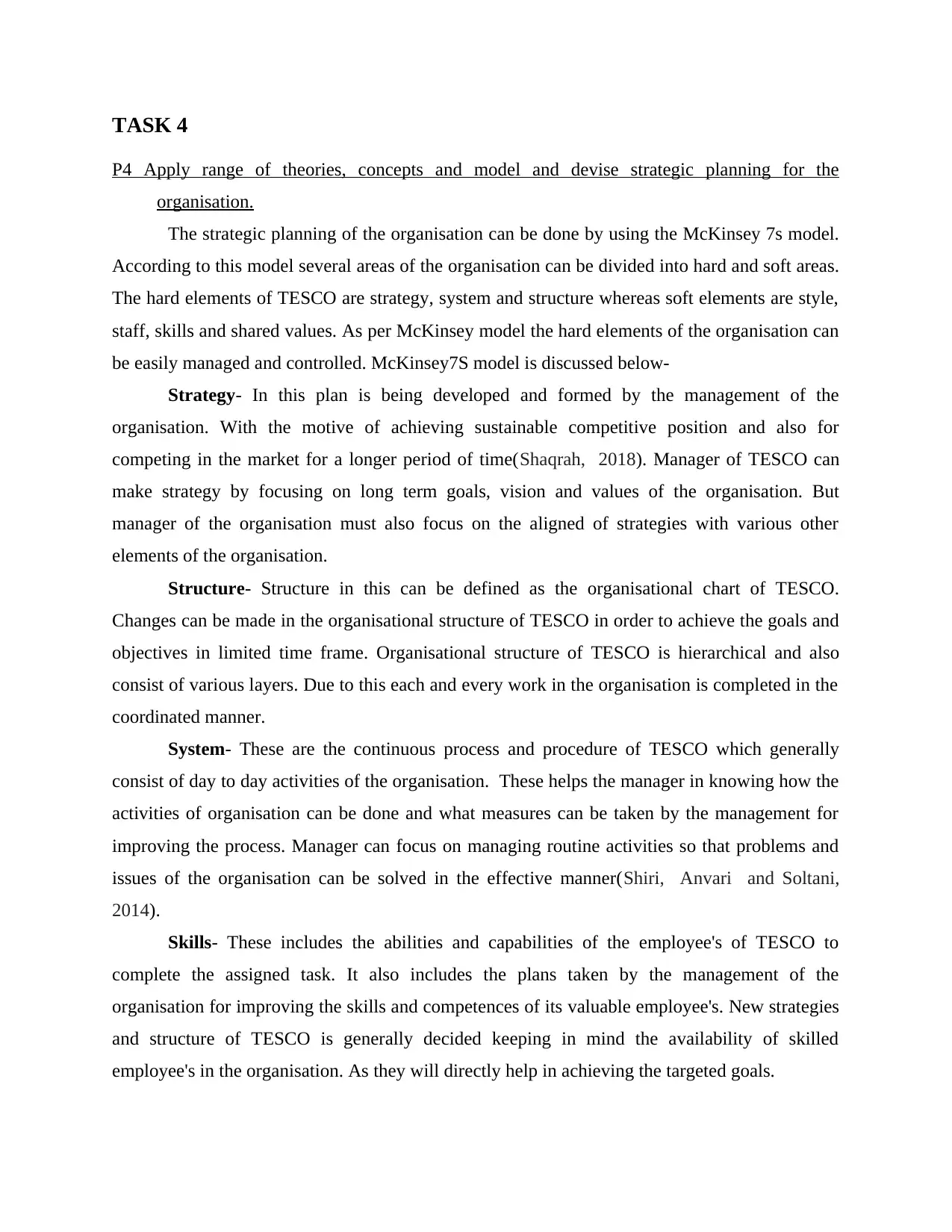
TASK 4
P4 Apply range of theories, concepts and model and devise strategic planning for the
organisation.
The strategic planning of the organisation can be done by using the McKinsey 7s model.
According to this model several areas of the organisation can be divided into hard and soft areas.
The hard elements of TESCO are strategy, system and structure whereas soft elements are style,
staff, skills and shared values. As per McKinsey model the hard elements of the organisation can
be easily managed and controlled. McKinsey7S model is discussed below-
Strategy- In this plan is being developed and formed by the management of the
organisation. With the motive of achieving sustainable competitive position and also for
competing in the market for a longer period of time(Shaqrah, 2018). Manager of TESCO can
make strategy by focusing on long term goals, vision and values of the organisation. But
manager of the organisation must also focus on the aligned of strategies with various other
elements of the organisation.
Structure- Structure in this can be defined as the organisational chart of TESCO.
Changes can be made in the organisational structure of TESCO in order to achieve the goals and
objectives in limited time frame. Organisational structure of TESCO is hierarchical and also
consist of various layers. Due to this each and every work in the organisation is completed in the
coordinated manner.
System- These are the continuous process and procedure of TESCO which generally
consist of day to day activities of the organisation. These helps the manager in knowing how the
activities of organisation can be done and what measures can be taken by the management for
improving the process. Manager can focus on managing routine activities so that problems and
issues of the organisation can be solved in the effective manner(Shiri, Anvari and Soltani,
2014).
Skills- These includes the abilities and capabilities of the employee's of TESCO to
complete the assigned task. It also includes the plans taken by the management of the
organisation for improving the skills and competences of its valuable employee's. New strategies
and structure of TESCO is generally decided keeping in mind the availability of skilled
employee's in the organisation. As they will directly help in achieving the targeted goals.
P4 Apply range of theories, concepts and model and devise strategic planning for the
organisation.
The strategic planning of the organisation can be done by using the McKinsey 7s model.
According to this model several areas of the organisation can be divided into hard and soft areas.
The hard elements of TESCO are strategy, system and structure whereas soft elements are style,
staff, skills and shared values. As per McKinsey model the hard elements of the organisation can
be easily managed and controlled. McKinsey7S model is discussed below-
Strategy- In this plan is being developed and formed by the management of the
organisation. With the motive of achieving sustainable competitive position and also for
competing in the market for a longer period of time(Shaqrah, 2018). Manager of TESCO can
make strategy by focusing on long term goals, vision and values of the organisation. But
manager of the organisation must also focus on the aligned of strategies with various other
elements of the organisation.
Structure- Structure in this can be defined as the organisational chart of TESCO.
Changes can be made in the organisational structure of TESCO in order to achieve the goals and
objectives in limited time frame. Organisational structure of TESCO is hierarchical and also
consist of various layers. Due to this each and every work in the organisation is completed in the
coordinated manner.
System- These are the continuous process and procedure of TESCO which generally
consist of day to day activities of the organisation. These helps the manager in knowing how the
activities of organisation can be done and what measures can be taken by the management for
improving the process. Manager can focus on managing routine activities so that problems and
issues of the organisation can be solved in the effective manner(Shiri, Anvari and Soltani,
2014).
Skills- These includes the abilities and capabilities of the employee's of TESCO to
complete the assigned task. It also includes the plans taken by the management of the
organisation for improving the skills and competences of its valuable employee's. New strategies
and structure of TESCO is generally decided keeping in mind the availability of skilled
employee's in the organisation. As they will directly help in achieving the targeted goals.
⊘ This is a preview!⊘
Do you want full access?
Subscribe today to unlock all pages.

Trusted by 1+ million students worldwide
1 out of 16
Related Documents
Your All-in-One AI-Powered Toolkit for Academic Success.
+13062052269
info@desklib.com
Available 24*7 on WhatsApp / Email
![[object Object]](/_next/static/media/star-bottom.7253800d.svg)
Unlock your academic potential
Copyright © 2020–2025 A2Z Services. All Rights Reserved. Developed and managed by ZUCOL.




